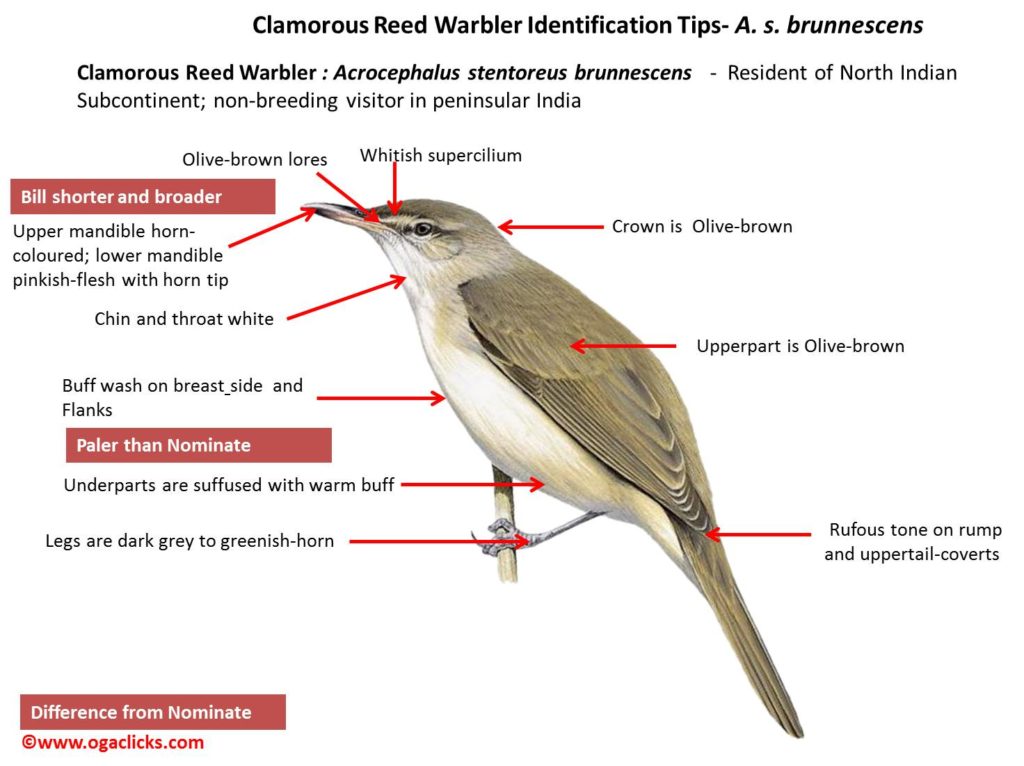
Clamorous Reed Warbler Acrocephalus stentoreus
Etymology :
Nominate:
- Acrocephalus :Greek word akros –topmost, highest ; kephale – head
- Stentoreus: Greek mythology Stentor, loud-voiced Greek warrior at Troy
Sub-species:
- s. brunnescens- Indian Reed Warbler – Latin word for “ Brownish” derived from brunneus –brown
- s. amyae- Named after Amy Stevens née Ellis (1881-1956) wife of British explorer Herbert Stevens
- s. meridionalis – Latin word – southern derived from meridies –
Distribution in India:
- s. brunnescens- Indian Reed-warbler– Resident of North Indian Subcontinent; non-breeding visitor in peninsular India
- s. amyae- Resident of North East India (plains of River Brahmaputra, in Assam)
- s. meridionalis– Resident of South India
Description: Size of 18–20 cm; Wt. of 23–34 g. It is a large plain reed-warbler with rather conspicuous supercilium. The nominate race has whitish supercilium, olive-brown lores, cheek and ear-coverts. The upperparts are warm olive-brown, with rufous tone on rump and uppertail—coverts. The flight-feathers are dark brown, edged paler, tertials and upperwing-coverts are warm olive-brown. The tail is brown; chin and throat are white, sometimes with few dark shaft streaks. The underparts are suffused with warm buff; iris is dark. The upper mandible is horn-coloured; lower mandible is pinkish-flesh with horn tip. The legs are dark grey to greenish-horn. .Both the sexes are alike. The juvenile is similar to adult but generally more bright rusty ochre, especially on underparts. Race brunnescens is less rufous above than nominate, also distinctly paler and whiter below and on flanks, with wing longer but bill is shorter and broader; race amyae is smaller and darker than previous; race meridionalis is smaller and darker and has fulvous-grey wash over chest.
Habitat: It is found in Papyrus stands, reeds around lakes, ponds and along rivers, reedmace, and riverside scrub, bushes along irrigation ditches, mangroves, Pandanus, and elephant grass. It breeds also in very small clumps of reeds along mountain streams. It is found up to 3000 m in Himalayas. On migration it is also found in dry habitats, such as acacia scrub, tamarisk, sugar cane and other cultivation.
Food Habits: It eats insects like dragonflies and damselflies, mayflies, stoneflies, grasshoppers and other orthopterans, mantises, bugs, adult and larval lepidopterans, caddis flies, flies, hymenopterans, beetles, slugs, snails, young frogs and seeds of aquatic plants. It forages mainly low down within reeds or bushes, near or over water. It takes food also from water surface, from floating vegetation, and by hopping about on ground near water in marshy habitat. It feeds also in trees near reedbeds.
Breeding habits: They breed Mar–Aug in Indian Subcontinent and Jun and Jul in Kashmir. They are monogamous. The nest is built mainly by female. The nest is a neat, deep and massive cylindrical cup of dry reed leaves, reed flowers, other plant fibres and grasses, lined with finer material like wool, horsehair, sedges, dry moss and rushes, placed above water in reeds or other aquatic vegetation. They lay a clutch of 3–6 eggs. The incubation is by female alone. The incubation period is 13–15 days. The nestling period is 11–13 days.